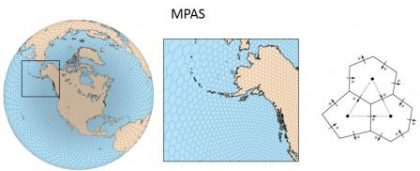ARL Weekly News – April 23, 2021
| Recent Events |
WMO Global Climate Observing System (GCOS)
As a member of the WMO Global Climate Observing System (GCOS) Surface Reference Network (GSRN) Task Team, Dr. Howard Diamond will be attending the virtual 2nd GSRN Task Team Meeting from April 28-29 and will make a presentation on the U.S. Climate Reference Network (USCRN) that he manages for ARL. The USCRN is considered to be a model for what the Task Team will be looking at for eventual development and deployment on a global basis.
NOAA General Modeling Meeting and Fair
Three virtual posters related to ARL’s research on atmospheric composition modeling were presented at NOAA’s General Modeling Meeting and Fair on April 16th.
- Daniel Tong presented How Well Can We Predict Wildfire Plumes? Lessons learned from large ensemble experiments, which described research on creating wildfire smoke plume ensembles with HYSPLIT for the 2018 Camp fire in the Western U.S.
- Patrick Campbell presented An Improved National Air Quality Forecasting Capability Using the NOAA Global Forecast System, which outlined recent work on the creation of a new air quality forecasting system that is slated to become operational in the National Weather Service this July.
- Barry Baker presented Implementation of the NOAA ARL FENGSHA Dust Emissions Scheme and Development of the NOAA Emission and eXchange Unified System for UFS Models, which described ongoing research to provide an emissions processing system for NOAA aerosol and atmospheric composition models in the Unified Forecast System.
Paper Accepted: Establishing the Suitability of the Model for Prediction Across Scales for Global Retrospective Air Quality Modeling.
Dr. Patrick Campbell is a co-author (with colleagues at the U.S. EPA) of a new paper in JGR-Atmospheres entitled: Establishing the Suitability of the Model for Prediction Across Scales for Global Retrospective Air Quality Modeling.
Plain Language Summary: The US EPA analyses and performs research on the past, present and future air quality of the United States using the Community Multiscale Air Quality model (CMAQ). Historically, the modeling was focused on the U.S. as regulations and impact are first order local issues. Global modeling is becoming more attainable and common as computer potential has increased, modeling systems advanced and air quality viewed as a global issue. This research demonstrates that we now have a meteorological modeling system that is capable of modeling air quality from global to local scales. The more comprehensive air quality modeling will directly address research issues on the link between air quality and human/ecological health. Specific results presented with this work indicate that the meteorology from the new global model is on par with the meteorology we have been using for the last decade. This suggests that the global air quality simulations will not be significantly restricted by poor driving meteorology and we can move forward with some confidence.
The transition from large grid cells at the global scale to fine cells at the near-urban and urban scales is seamless (left). The size of the grid cells can change dramatically, albeit smoothly, over hundreds of kilometers (middle). The angles, side lengths and even the number of sides of each grid cell is variable throughout the model grid.

The transition from large grid cells at the global scale to fine cells at the near-urban and urban scales is seamless (left). The size of the grid cells can change dramatically, albeit smoothly, over hundreds of kilometers (middle). The angles, side lengths and even the number of sides of each grid cell is variable throughout the model grid.
Reference: Gilliam, R. C., Herwehe, J. A., Bullock, O. R., Pleim, J. E., Ran, L., Campbell, P. C., & Foroutan, H. (2021). Establishing the Suitability of the Model for Prediction Across Scales for Global Retrospective Air Quality Modeling. Journal of Geophysical Research: Atmospheres, 126, e2020JD033588. https://doi.org/10.1029/2020JD033588

